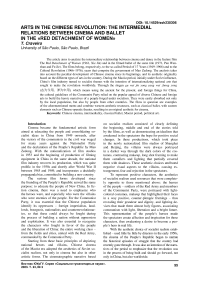Arts in the Chinese revolution: the intermedial relations between cinema and ballet in the "Red detachment of women"
Бесплатный доступ
The article aims to analyze the intermediary relationship between cinema and dance in the feature film The Red Detachment of Women (1961, Xie Jin) and in the filmed ballet of the same title (1971, Pan Wenzhan and Fu Jie). The films belong, respectively, to the so-called Period of 17 Years (1949-1966) and to the Cultural Revolution (1966-1976), years that comprise the government of Mao Zedong. The analysis takes into account the peculiar development of Chinese cinema since its beginnings, and its aesthetic originality based on the different types of arts in the country. During the Maoist period, initially under Soviet influence, China’s film industry turned to socialist themes with the intention of internationalizing national arts that sought to make the revolution worldwide. Through the slogan gu wei jin yong yang wei zhong yong (古为今用 洋为中用), which means using the ancient for the present, and foreign things for China, the cultural guidelines of the Communist Party relied on the popular appeal of diverse Chinese and foreign arts to build the heroic narratives of a people forged under socialism. They were easily absorbed not only by the local population, but also by people from other countries. The films in question are examples of the aforementioned motto and combine western aesthetic resources, such as classical ballet, with eastern elements such as Chinese operatic theater, resulting in an original aesthetic for cinema.
Chinese cinema, intermediality, classical ballet, maoist period, political art
Короткий адрес: https://sciup.org/147241814
IDR: 147241814 | DOI: 10.14529/ssh230306
Список литературы Arts in the Chinese revolution: the intermedial relations between cinema and ballet in the "Red detachment of women"
- Costa J.M. da. Dados Históricos // Catálogo da mostra de Cinema Chines. Cinemateca Portuguesa. Lisboa, 1987.
- Chan J.K.Y. Chinese Revolutionary Cinema Propaganda: Aesthetics and Internationalism 19491966. I.B. Tauris, 2019.
- Harris K. Re-makes / Re-models: The Red Detachment of Women between Stage and Screen // The Opera Quarterly. 2010. Vol. 26, № 2-3. P. 316342. Oxford University Press.
- Clüver C. Intermidialidade // Belo Horizonte. 2011. Vol. 1. № 2. P. 8-23. URL: https://periodicos. ufmg.br/index.php/revistapos/article/view/15413.
- Rajewsky I. Border Talks: The Problematic Status of Media Borders in the current Debate about Intermediality // Media Borders, Multimmodality and Intermediality; ed Lars Ellestrom. Basingstoke: Palgrave Macmillan, P. 51-69, 2010. URL: _Border_ Talks_The_Problematic_Status_of_Media_Borders_in _the_Current_Debate_about_Intermediality_in_Lars_ Ellestrom_ed_Media_Borders_Multimodality_and_Inte rmediality_Basingstoke_Palgrave_Macmillan_2010_ pp_51_68.
- Rajewsky I.O. Intermidialidade, intertextual-idade e «remediagao»: uma perspectiva literária sobre a intermidialidade // DINIZ, T. F. N. (Org.). Intermidialidade e estudos interartes: desafios da arte contemporánea. Belo Horizonte: Editora UFMG, 2012.
- Diniz T.F.N. Intermidialidade: perspectivas no cinema // Revista Rumores. 2018. № 24. Vol. 12. URL: https://www.revistas.usp.br/Rumorss/article/view/ 143597.
- Dabat C.R. Mulheres no movimento revolu-cionário chines (1839-1949). Recife: Ed. Univer-sitária da UFPE, 2006.
- Nagib L. The Politcs of Impurity // Impure Cinema: Intermedial and Intercultural Approaches to Film; ed. L. Nagib and A. Jerslev. London: I.B. Tauris, 2014.
- Schober R. Translating sounds: intermedial exchanges in Amy Lowell's «Stravinsky's Three Pieces 'Grotesques' for String Quartet» // Media borders, multimodality and intermediality; Ed. L. Ellestrom. Nova York: Palgrave, 2011.
- Aguiar D. Danga e Intermidialidade: Relagoes, Convengoes e Fronteiras. Seminário Inter-naciona Trans-Incoporados // Tradugao, Remixagao e Disseminagao. Série Trans-In-Corporados. 2017. Vol. 2. LabCrítica. Rio de Janeiro. URL: https://labcritica. com.br/wp-content/uploads/2017/11/TRANS-IN-CORPORADOS_Caderno-de-resumos_2017.pdf.
- Berry C., Farquhar, M. «Operatic Modes» // Berry, Chris E Farquhar, Mary, China on Screen: Cinema and Nation. New York: Columbia University Press, 2006.
- Clark P. The Chinese Cultural Revolution: a history. Cambridge University Press, 2008.
- Pethó Á. Intermediality in Film // A Historiography of Methodologies in Acta Univ. Sapientiae, Film and Media Studies. 2010. № 2. P. 39-72. URL: https://www.academia.edu/253223/Intermediality_in_ Film_A_Historiography_of_Methodologies.
- The Red Detachment of Women [hongse niangzi jun 1961, Xie Jin, color, 92 niangzi jun Sfe^iW], 1971, Pan Wenzhen /Fu Jie, min, Tianma Studios, Shanghai, China. color, 105 min, Beijing Film Studios, Beijing, China.


